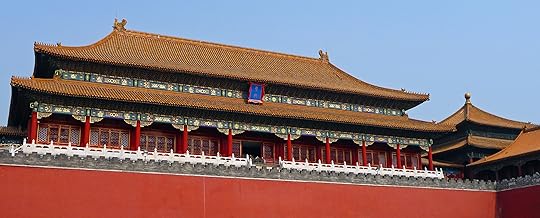Forbidden Frenzy

One would think that least of all, the former center of political and cultural life, the Palace Museum a.k.a. The Forbidden City, is the place you’d want to be. The entire nation has its annual celebration on October 1st and in the case of the sixtieth birthday party, it still hadn’t stopped when we arrived 8 days later. I can only say that I’m grateful our first stop was Shanghai because days later when we landed in Beijing, the festivities showed no sign of stopping.
I didn’t know what to expect of China’s ancient capital, but I had always been curious. Watching the Opening Ceremony of the 2008 Olympics in Singapore ratcheted that curiosity up several notches. Any country that could create such a spectacular with pure people power and creativity had to be worth a visit. I was not wrong.
On some level, I suppose the crowds helped put China and the Chinese in perspective. I can’t remember anywhere we went where we were alone and I suppose that gives an indication of why the Chinese always seem to travel in such large groups everywhere they go. They’re used to it. Smaller numbers must seem very odd to them.
Walking to the Forbidden City, a place I had to visit based on name alone, I felt a little nervous. Even though now it is a museum and no longer the home of the Chinese ruler, it still felt, well.. forbidden. The name comes from a literal Chinese translation of the word, although there is more than one theory to explain it. The most-accepted explanation is that its name comes from one law: No one could enter or leave the city without the permission of the emperor. That in itself is a little foreboding and we haven’t even gotten to the 26 foot wall that surrounds the place.
This complex of nearly 1000 buildings has been the home of 24 emperors over nearly 500 years. Its construction began in 1407 and it was closed in 1920. Over this period, 14 Ming dynasty emperors and 10 Qing dynasty emperors lived here with their courts and households. It is well-known as the result of two thousand years of Chinese architectural knowledge and was World Heritage listed in 1987 as having the largest collection of ancient wooden buildings in the world.
If that doesn’t impress you, consider that the area is over 3000 feet from north to south (960m) and 2500 feet (750m) from east to west. All of this is surrounded by a 170 foot (52m) moat in the heart of Beijing. Inside the walled complex, the layout is in concentric rectangles that get continually smaller. This is what is difficult to conceptualize from photos of the Forbidden City, the design which symbolizes the reduction of the number of people who could be in proximity to the emperor.
The closer we get to his actual throne and chambers, the smaller the surrounding space and the less people who could interact with the celestial being in man form known as the “Son of Heaven.”
Inside the Inner Court, you will find the private chambers of the emperor and the empress. The emperor lived in ‘The Temple of Heavenly Purity’ and the empress’ chambers are known as ‘The Palace of Earthly Tranquility’ between them is the Hall of Union where they mixed up their yin and yang together.
But it isn’t only these grand halls, courts, and chambers that are striking. Personally, I was transfixed by the size of something that had once likely held fire but looked like it could be the biggest flower pot you’ve ever seen. The enormous red doors with brass lion knockers will make you feel like the tiny Alice of Wonderland fame. Every single rooftop and wall is decorated with Chinese hieroglyphics that reflect their native Taoism. Embroidered dragons and heavenly bodies cover the gorgeous golden robes of the emperor. This ruler who kept thousands under his thumb every moment of every day was revered by millions but known to very few. I daresay those he trusted numbered even less.
To walk these grounds as others have done since the 15th century is extremely humbling. I had a similar feeling in Rome, the feeling that my worries were so insignificant and fleeting in light of centuries of human trials & tribulation. Standing next to the ‘Gate of Supreme Harmony’, built to hold a hundred thousand people, gives you a small idea of the number of stories that China has to tell. I can only hope one day to be back in the ‘Pavilion of Literary Profundity’ to find out more. It’s a good thing that we had plenty of company on this visit. A place so vast would otherwise feel very lonely–something the emperor knew all along.
The post Forbidden Frenzy appeared first on Worldwise Publications.



